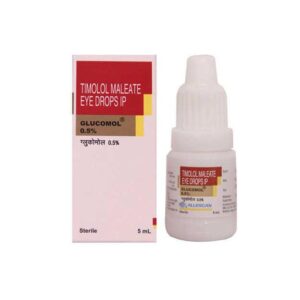TIMOLOL MALEATE + PILOCARPINE
Timolol Maleate: Timolol Maleate is a medication that belongs to the class of drugs called beta-adrenergic blockers. It is primarily used for the treatment of high blood pressure, glaucoma, and to prevent migraines.
In the treatment of high blood pressure, Timolol Maleate works by blocking the action of certain natural substances in the body, specifically adrenaline, which leads to a lowering of blood pressure and heart rate. In glaucoma, it reduces the production of fluid in the eye, thereby decreasing intraocular pressure. The exact mechanism by which it prevents migraines is not fully understood.
The dose of Timolol Maleate can vary depending on the condition being treated. For high blood pressure, the usual starting dose is usually 10 mg taken orally once or twice daily, but this can be adjusted depending on the response. In glaucoma, it is usually administered as eye drops, with one drop in the affected eye(s) twice daily.
While Timolol Maleate is generally well-tolerated, it may cause some side effects. Common side effects can include dizziness, fatigue, nausea, gastrointestinal discomfort, and slow heart rate. Less common but more serious side effects may include shortness of breath, chest pain, fainting, depression, and symptoms of an allergic reaction such as rash, itching, or swelling.
As with any medication, it is important to consult with a healthcare professional before starting Timolol Maleate to ensure it is appropriate for your individual situation and to discuss potential side effects or interactions with other medications.
Pilocarpine: Pilocarpine is a medication that is primarily used to treat conditions such as glaucoma and dry mouth (xerostomia) caused by radiation therapy or Sjögren’s syndrome.
Mechanism of Action:
Pilocarpine belongs to the class of drugs called cholinergic agonists. It works by activating certain receptors (muscarinic receptors) in the body, which stimulates the parasympathetic nervous system. In glaucoma, pilocarpine helps to reduce intraocular pressure by increasing the outflow of fluid from the eye. In cases of dry mouth, pilocarpine stimulates the salivary glands to produce more saliva.
Dose:
The dose of pilocarpine varies depending on the condition being treated. For glaucoma, it is commonly available as eye drops in strengths of 0.5%, 1%, and 2%. Typically, one drop is administered into the affected eye(s) every 6-12 hours. The dose may be adjusted based on the individual’s response. For dry mouth, pilocarpine is usually available as oral tablets or sublingual tablets, with recommended doses ranging from 5mg to 10mg, usually taken 3-4 times a day.
Side Effects:
Common side effects of pilocarpine include increased sweating, increased tear production, blurred vision, headache, nausea, and dizziness. These side effects are usually mild and temporary. Pilocarpine eye drops can sometimes cause temporary stinging or burning in the eyes after application. In some cases, pilocarpine may cause a decrease in night vision or changes in near vision. Due to its stimulatory effects on the body, pilocarpine should be used with caution in individuals with cardiovascular diseases, asthma, epilepsy, or urinary obstruction. It is important to discuss all medications and medical conditions with a healthcare provider before starting pilocarpine.

